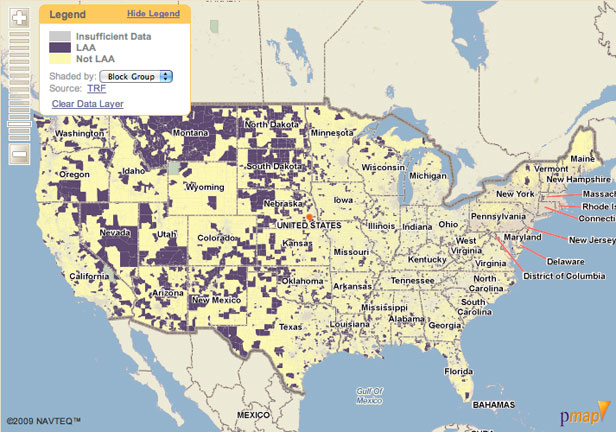 A new tool maps Low-Access Areas — those where residents can’t easily get to a supermarket — around the U.S.PolicyMap
A new tool maps Low-Access Areas — those where residents can’t easily get to a supermarket — around the U.S.PolicyMap
Earlier this month, in a piece for our Feeding the Cities series, Stephanie Paige Ogburn explained how urban “food deserts,” areas without grocery stores selling healthy food and fresh produce, came to be:
Talk with healthy-food advocates in urban centers across the country, and frequently, you’ll hear the same story. It goes something like this:
Once upon a time, this city was full of grocery stores. Then came urban renewal/an economic downturn/a mass exodus of the wealthy and, one by one, the groceries closed up and moved to the outskirts of the city. Since then, there have been Safeways/Krogers/Publix that have set up shop here and there, but they all end up leaving. Now we have 100 liquor stores for 25,000 people in this part of town, and the closest these stores come to selling fruit is the Arbor Mists in the drink cooler.
For an area to be a true “food desert,” it needs not only to be sans a full-service grocery store, but also populated primarily by low-income families that don’t have cars or easy public-transit access to stores outside their neighborhood.
A very interesting new tool has just been released by The Reinvestment Fund, a community investment group (which played a key role in the much-emulated Pennsylvania Fresh Food Financing Initiative), working with the Brookings Metropolitan Policy Program. It layers data about supermarket presence with income levels, public-transit commuting, federal nutrition and housing program participation, and other key demographics to pinpoint those communities it calls Low-Access Areas — those most affected by the lack of a full-service supermarket.
The point of the project isn’t just to map food deserts, it’s to help TRF and other investors, as well as policymakers, calculate how much money is “leaking” from an area (being spent elsewhere), so as to evaluate whether a loan for a new supermarket is a good idea — financially, presumably. As Stephanie covered in her piece, food-justice advocates disagree on whether small, independently owned but somewhat limited food stores are the answer, or chain stores such as a Safeway or Walmart.
Alas, the tool does not include data for health care expenditures or obesity rates in these areas, which would be interesting comparisons to see.




